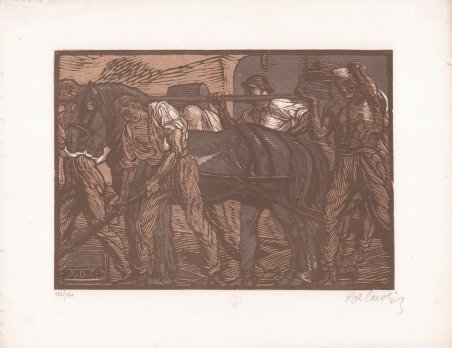Xilografia a due legni, 1923, siglata sul legno in basso a sinistra. Firmata a matita in basso a destra. Numerata a matita in basso a sinistra: 132/154. misure: mm 170 x 245. Timbro a secco in basso al centro. Impressione eccellente su carta avorio liscia. Ottimo stato di conservazione. Ampi margini oltre la linea marginale. Pittore, incisore e illustratore italiano. Si forma inizialmente a Bologna all’Accademia di Belle Arti e una volta ottenuto il diploma, nel 1892 si trasferisce a Roma. Qui conosce il poeta Nino Costa fondatore del cenacolo In arte libertas che proponeva un rinnovamento dell’arte attraverso la riscoperta dei grandi del Quattrocento sull’esempio dei Preraffaelliti. De Carolis inizia così a frequentare questo gruppo e ne diventa membro iniziando a realizzare dipinti di impronta preraffaellita. Nel 1900 conosce il poeta Giovanni Pascoli per il quale disegna ed esegue un pomo in argento e la targhetta per il bastone dono degli amici della rivista fiorentina Marzocco, inizia quindi ad occuparsi della decorazione grafica di alcune pubblicazioni del poeta. Tale collaborazione si rivela importante nella produzione artistica tra il 1892 e il 1928, perché le opere di questo periodo trattano paesaggi agresti e marini che risentono dell’intonazione pascoliana. Nel 1901 De Carolis lascia Roma per Firenze, dove insegna ornato all’Accademia di Belle Arti dedicandosi alla xilografia. Questa tecnica sarà a lui molto cara e primo in Italia riprenderà l’antica tecnica della xilografia policroma a più legni. Numerose saranno i fogli singoli o le illustrazioni per varie riviste e per le opere dell’amico D’Annunzio. ' Bibliografia Bardazzi/Carli/Djokic, 50. Amadio/Papetti, 78-79. Conti, 29. Woodcut from two block, 1923, signed at lower left. igned in pencil at lower right. Numbered in pencil lower left: 132/154. Sice: 170 x 245 mm. Dry stamp at bottom center. Excellent impression on smooth ivory paper, wide margins. Size: mm 170 x 245. Adolfo de Carolis (1874 - 1926), was born in Montefiore dell’Aso on the 6th of January 1874. ' He moved to Rome and was accepted as a member of the exclusive society ‘In Arte Libertas’ (Freedom in Art’) which had been founded by his close friend Giovanni (‘Nino’) Costa. This society opposed official styles promoted by the academies and influential art critics of the day and espoused the politics, philosophy and aesthetics of the British Pre-Raphaelite movement. The main figures in the British movement were William Morris, ' Dante Gabriel Rossetti, Edward Burne-Jones and ' Walter Crane. These groups were also almost certainly involved with the Freemasons, and much of the symbolism in their work have been identified as Masonic. ' De Carolis exhibited work at the In Arte Libertas annual exhibition right up to 1901. De Carolis was an artistic polymath, working as a painter (in particular of murals), interior designer, decorator, xylographer (wood engraver), illustrator and photographer, and is probably the best known exponent of Art Nouveau in Italy. He was commissioned to produce murals for the Villa Brancadoro in ' San Benedetto del Tronto, and the ballroom of the Palazzo della Provincia (both in Ascoli Piceno). He also decorated ' the ' great hall of the Palazzo del Podestà ' in ' Bologna with murals. He designed the Baptismal Font at the Cathedral of ' Ajaccio, and contributed decoration and murals in many other illustrious edifices around Italy, as well as supervising restoration work in the Borgia apartments in the Vatican. He is also known for his stained glass and mosaics at the Villa Puccini in Torre del Lago. His talent and originality was quickly recognised by two of the greatest Italian writers and poets of the day, Gabriele D'Annunzio and Giovanni Pascoli, and he became their preferred illustrator. Among his most popular works were many illustrations for ' Gabriele d'Annunzio's novels (Il Notturno, ' La figlia di Jorio) and ' Giovanni Pascoli‘s books of poems. ' In 1908 his work was described by a panel of judges in Bologna as ‘magnificent, full of evocative fervour, rich in imagination, and secure in the unity of the whole work’. In the backgrounds of many of his paintings it is possible to recognise the typical landscape of le Marche, which he loved so much. As well as his major works, in his later years he also designed bank notes, theatrical sets, posters, calendars, postcards, advertisements and even product labels. He also wrote essays on art and, from 1922, worked as a teacher at the Academy of Fine Arts in Rome. After world war 1 he was employed by the Ministry of War to design medals and certificates for war heroes. He died in Rome on the 7th of February 1928, but, in 1950, his mortal remains were returned to Montefiore by the then mayor, Francesco Egidi, and re-interred in a marble tomb in the church of San Francesco. And ten years later Egidi donated a series De Carolis’ oil sketches for the ‘Salone del Podestà’ in Bologna (the most prestigious public building in the city) which he worked on for over twenty years, between 1908 and 1928. ' The De Carolis family also donated the complete collection of engravings on wood (xylography) in 1976. Cfr.


Find out how to use
Find out how to use

